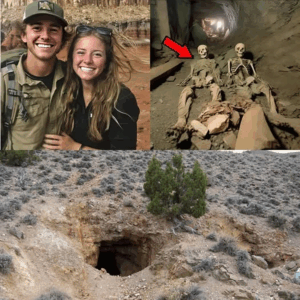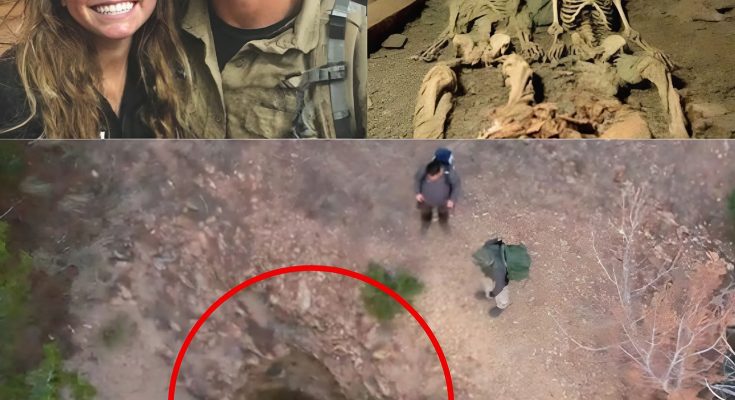A Weekend That Should Have Been Ordinary
In late spring of 2011, Sarah Bennett, 26, and Andrew Miller, 28, packed their camping gear into the trunk of their car in Colorado. They weren’t adventurers chasing danger, nor were they reckless thrill-seekers. They were simply two people in love, eager to escape their routines and spend a quiet weekend under the desert stars of Utah.
They planned to hike, take photos, camp for two nights, and return by Sunday evening. It was meant to be uneventful — just a brief escape from city life.
But they never came back.

The First Signs Of Trouble
When Sarah and Andrew failed to return by Monday morning, their families grew anxious. Calls went unanswered. Their car was found parked near a remote trailhead in southern Utah, but there were no footprints, no gear scattered, no immediate sign of struggle.
Search teams mobilized. Helicopters scanned the desert. Volunteers combed canyons and ridges. For weeks, the area buzzed with activity. But the landscape was unforgiving — vast expanses of rock, shifting sands, and labyrinthine slot canyons that swallowed sound and sight alike.
Despite all efforts, not a single clue surfaced.
A Mystery That Faded Into Silence
As months turned into years, the mystery of Sarah and Andrew slipped from national headlines into the shadows of unsolved cases. Their families kept hope alive, clinging to the possibility that perhaps the couple had wandered farther than expected, or that they had been forced to disappear under strange circumstances.
But every lead grew cold. Every theory ended in silence.
The desert, it seemed, had swallowed them whole.
The Return Of Investigators
In 2019, nearly eight years later, a new investigative team revisited the area. Technology had advanced, and fresh eyes often revealed details missed before.
This time, the team brought a K-9 unit trained in scent detection. As the dog padded through the scrubland, ears pricked and nose low to the ground, it suddenly froze, then bolted toward an overgrown path leading to a cluster of forgotten mines.
Among them was an abandoned uranium shaft, its entrance half-collapsed, its air heavy with the metallic tang of time.
The Discovery
Inside, flashlights cut through the dark. Dust swirled in the beams, settling on rusted equipment, scattered debris, and graffiti left by wanderers decades earlier.
And then, at the far end of the tunnel, the team saw them.
Two figures, seated side by side on the cold ground. Sarah Bennett and Andrew Miller.
Their remains rested as though they had simply sat down to catch their breath — Sarah leaning slightly toward Andrew, Andrew’s arm half-curved as if he had once meant to hold her.
For years, they had been there, preserved in the silence of the mine.
The Shockwave
News of the discovery rippled across Colorado and Utah, reopening wounds that had never fully healed. Families who had endured nearly a decade of uncertainty now had answers, but not the ones they had prayed for.
The question shifted from Where are they? to How did they get here?
Theories Begin
Investigators pieced together possible scenarios:
Accidental Entry. Perhaps Sarah and Andrew had stumbled upon the mine, curious, and entered without realizing its dangers. Old shafts often contain toxic air or unstable ground. A single misstep could have trapped them inside.
Seeking Shelter. Some suggested they might have sought refuge from sudden desert weather — a storm, extreme heat, or even nightfall. In such cases, a mine can appear to be a temporary sanctuary.
Something More. Rumors swirled of foul play, of the possibility that they had not gone there willingly. Yet there were no clear signs of struggle, no evidence to prove the theory.
The truth lay buried as deeply as the mine itself.
The Desert’s Grip
Utah’s desert is both breathtaking and merciless. Temperatures swing from scorching by day to freezing at night. Distances deceive the eye — what looks close may take hours to reach. Hidden dangers lurk in abandoned mines, where oxygen runs thin and silence is absolute.
For Sarah and Andrew, what started as a romantic weekend had become a labyrinth with no escape.

Families Confront The Truth
When authorities confirmed the identities, families gathered for memorials. Tears flowed, but so did a strange kind of relief — at last, their loved ones had been found.
“I can finally stop wondering every night where they are,” Sarah’s mother said quietly. “Now I know. Now I can let her rest.”
Andrew’s brother echoed the sentiment. “The desert held them for eight years. Now we bring them home.”
The Symbolism Of Their Position
What unsettled investigators most was the way they were found: sitting side by side, as though they had accepted their fate together.
There were no signs of frantic clawing at walls, no evidence of panic. Instead, it appeared that, when faced with despair, they chose to remain together until the end.
That image — of love persisting even in death — became etched in the minds of everyone who heard their story.
The Public Reaction
As the news spread, people across the country debated what might have happened. Forums lit up with speculation. Documentaries began circling the idea of a feature. The story was haunting not just for its mystery, but for its humanity.
Two ordinary people. A weekend trip. A tragic end hidden for nearly a decade.
It could happen to anyone.
Abandoned Mines: A Hidden Danger
The case shone a spotlight on abandoned uranium mines scattered across the American West. Thousands of them lie forgotten, relics of a bygone era, yet they remain dangerous. Unstable structures, toxic gases, and hidden shafts make them lethal to the curious and unsuspecting.
Officials renewed calls to secure or seal these sites, warning that Sarah and Andrew’s fate should serve as a chilling reminder.
Love In The Darkness
Despite the tragedy, many found a kind of poetry in how Sarah and Andrew were discovered. They hadn’t been torn apart. They hadn’t been separated by distance or time. Even in death, they had remained together, seated side by side in silence.
Some saw it as a testament to their bond. Others saw it as the desert’s cruelest irony — that love had endured, but life had not.
Eight Years Of Silence
From 2011 to 2019, their absence had been a void. Every birthday, every holiday, their families had lived with unanswered questions. And all the while, just miles from where searchers had scoured, they sat in that mine, waiting for discovery.
The silence of those years now feels deafening.
What Remains Unanswered
Even with their bodies found, questions persist:
Why did they enter the mine?
How long did they survive once inside?
Did they call for help, or did the walls of the mine swallow their cries?
Perhaps those answers will never come. The desert keeps its secrets well.
Conclusion: A Whisper From The Desert
The story of Sarah Bennett and Andrew Miller is more than a tale of disappearance. It is a reminder of life’s fragility, of how quickly the ordinary can turn extraordinary, and how love can endure even in the harshest places.
They left for a weekend trip, intending to return to Colorado by Sunday night. Instead, they became part of the desert’s haunting history, discovered only because a dog’s nose caught the faint trace of time.
In the end, they were found not as victims torn apart, but as companions seated together in silence — a whisper from the desert about love, loss, and the mysteries that still linger beneath the surface of the earth.



